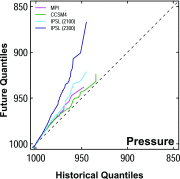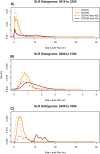Impact of climate change on New York City's coastal flood hazard: Increasing flood heights from the preindustrial to 2300 CE
- PMID: 29078274
- PMCID: PMC5692530
- DOI: 10.1073/pnas.1703568114
Impact of climate change on New York City's coastal flood hazard: Increasing flood heights from the preindustrial to 2300 CE
Abstract
The flood hazard in New York City depends on both storm surges and rising sea levels. We combine modeled storm surges with probabilistic sea-level rise projections to assess future coastal inundation in New York City from the preindustrial era through 2300 CE. The storm surges are derived from large sets of synthetic tropical cyclones, downscaled from RCP8.5 simulations from three CMIP5 models. The sea-level rise projections account for potential partial collapse of the Antarctic ice sheet in assessing future coastal inundation. CMIP5 models indicate that there will be minimal change in storm-surge heights from 2010 to 2100 or 2300, because the predicted strengthening of the strongest storms will be compensated by storm tracks moving offshore at the latitude of New York City. However, projected sea-level rise causes overall flood heights associated with tropical cyclones in New York City in coming centuries to increase greatly compared with preindustrial or modern flood heights. For the various sea-level rise scenarios we consider, the 1-in-500-y flood event increases from 3.4 m above mean tidal level during 1970-2005 to 4.0-5.1 m above mean tidal level by 2080-2100 and ranges from 5.0-15.4 m above mean tidal level by 2280-2300. Further, we find that the return period of a 2.25-m flood has decreased from ∼500 y before 1800 to ∼25 y during 1970-2005 and further decreases to ∼5 y by 2030-2045 in 95% of our simulations. The 2.25-m flood height is permanently exceeded by 2280-2300 for scenarios that include Antarctica's potential partial collapse.
Keywords: New York City; coastal flooding; flood height; sea-level rise; tropical cyclones.
Copyright © 2017 the Author(s). Published by PNAS.
Conflict of interest statement
The authors declare no conflict of interest.
Figures















Comment in
-
Rising hazard of storm-surge flooding.Proc Natl Acad Sci U S A. 2017 Nov 7;114(45):11806-11808. doi: 10.1073/pnas.1715895114. Epub 2017 Oct 24. Proc Natl Acad Sci U S A. 2017. PMID: 29078412 Free PMC article. No abstract available.
References
-
- NYC Special Initiative for Rebuilding and Resiliency (2013) A stronger, more resilient New York (PlaNYC, New York)
-
- Kemp AC, Horton BP. Contribution of relative sea-level rise to historical hurricane flooding in New York City. J Qua Sci. 2013;28:537–541.
-
- Lin N, Emanuel KA, Oppenheimer M, Vanmarcke E. Physically based assessment of hurricane surge threat under climate change. Nat Clim Chang. 2012;2:462–467.
-
- Little CM, et al. Joint projections of US East Coast sea level and storm surge. Nat Clim Chang. 2015;5:1114–1120.
Publication types
MeSH terms
LinkOut - more resources
Full Text Sources
Other Literature Sources
Medical

